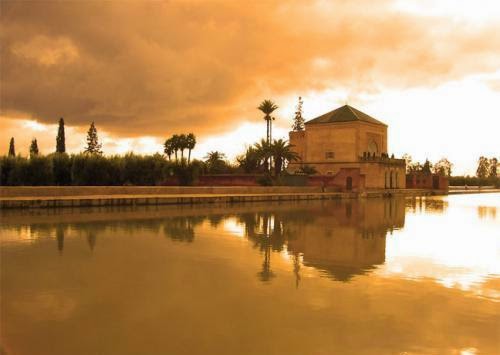Majorelle garden
In 1919 the French painter Jacques Majorelle (1886-1962) (son of the famous cabinetmaker art nouveau decorative artist Louis Majorelle Nancy) settled in the Medina of Marrakech (during the French protectorate in Morocco) and falls in love.
In 1922 he bought a palm grove bordering that of Marrakech, northwest of the medina, and in 1931, built by architect Paul Sinoir its Moorish / Art Deco architecture style villa astonishingly modern, inspired architect Le Corbusier. He set up his main house on the first floor and a large artist's studio on the ground floor to paint its huge decorations.
Lovers of botany, botanical garden he created his Islamic-inspired garden with lush tropical gardens around his house, "an impressionistic garden", "a cathedral of shapes and colors," structured around a long central basin with more varied environments, where hundreds of birds nest. This garden is a living work of art in motion, with exotic plants and rare species he brought back from his travels around the world: cactus, yuccas, lilies, lotus, lilies, jasmine, bougainvillea, palm trees, coconut trees , banana, bamboo, carob trees, agaves, cypresses ... and adorned with fountains, ponds, fountains, ceramic jars, paths, pergolas ...
In 1937 the artist creates the blue Majorelle, an ultramarine blue / cobalt both intense and clear that he painted the walls of his villa, then the whole garden into a tableau that opens to the public in 1947.
Following a car accident, Majorelle is repatriated to Paris where he disappeared in 1962 The garden is then abandoned for several years.
Yves Saint Laurent
Yves Saint Laurent and Pierre Bergé discover the Jardin Majorelle in 1966, during their first stay in Marrakech "Furnes seduced us with this oasis where the colors of Matisse mingle with those of nature." They bought the Majorelle Garden in 1980 to save a proposed hotel complex which provided her disappearance; This will be the third acquisition of the couple in the city of Marrakech. The new owners decided to live in the house of the artist, renamed Villa Oasis, and are undertaking major restoration of the garden to "make the most beautiful garden Majorelle Garden, one Jacques Majorelle had thought, envisaged". The artist's studio is transformed into a Berber museum open to the public and in which the Yves Saint Laurent and Pierre Bergé collection is exposed.
Disappeared on June 1, 2008 in Paris, the ashes of Yves Saint Laurent are scattered in the rose garden of the Villa Oasis and a memorial, consisting of a Roman column reduced from Tangier placed on a pedestal where a plaque bears his name. November 27, 2010, Princess Lalla Salma, wife of King Mohammed VI of Morocco opens the exhibition Yves Saint Laurent and Morocco along with the creation of the street Yves Saint Laurent.
On 3 December 2011, the Berber museum was inaugurated on the ground floor of the villa in the presence of French culture minister Frederic Mitterrand, and the house where lived Yves Saint Laurent is labeled houses Illustrious.
To date, the garden, maintained by a score of gardeners, is one of the most visited Marrakech and Morocco with more than 600,000 annual visitors attraction.
botanical collections
• Collection of cacti.
• Collection of bananas.
• Rare Plants: Aloe driveway.
• Collection of palm trees is a cool oasis in the southern part of the garden.
• Bamboo south and west of the garden between the boundary wall and winding road.
ornithology
The song of the bulbul gardens welcomes visitors who discover alongside common species such as blackbird, house sparrow robin and great tit less common species of warblers, gray wagtail, the Striolated the bunting red tail black and gray flycatcher.
Doves and pigeons are numerous. A kestrel nicherait in tour1. The five species of the most visible from the flat roofs of Marrakech birds are the white stork, gray wagtail, the turtle dove, kestrel, gray flycatcher.
















